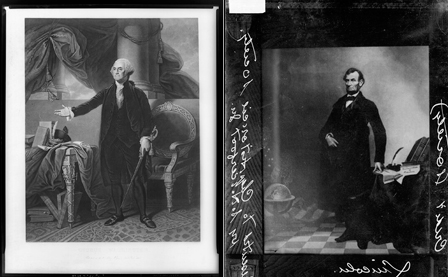Learning from the Source: Presidential Portraits

George Washington and Abraham Lincoln are two of the most famous U.S. presidents. This project helps students to learn about these presidents through the lens of both primary and secondary sources. Students will also investigate different types of primary sources, learn how portraits are created to convey information, and consider their own presidential potential.
To complete this project, students will . . .
- identify various types of primary sources.
- learn facts about George Washington and Abraham Lincoln.
- compare and contrast facts about Washington and Lincoln.
- use objective and subjective techniques to analyze historic and contemporary images.
- compile autobiographical information (actual and future).
- draw conclusions about how images portray people and, sometimes, influence what we think about the person portrayed.
- arrange and pose for their own presidential portraits.
Objectives
Upon completing this project, students will be able to . . .
- identify various types of primary sources.
- identify as well as compare and contrast facts about George Washington and Abraham Lincoln.
- analyze historic and contemporary images using objective and subjective techniques.
- discuss how portraits are created to convey information.
- convey their own views of what it means to be a presidential leader.
Standards
This project meets the following Common Core English Language Arts Standards for grades 3-5.
Reading Standards for Informational Text: 1, 2, 4, 6, 7, 8, 9, 10
Writing Standards: 2, 3, 4, 8, 9, 10
Speaking and Listening Standards: 1, 2, 3, 4
Guidelines
Review background information: Students will need basic understanding of primary sources to complete this project. For ideas on how to present this information, take a look at one of the online interactives listed below.
- Examples of Primary Sources University of Illinois Library
- Types of Primary Sources Michigan State University Libraries
Be flexible with implementation: Consider having students work individually, in pairs, or in groups.
Materials
Texts
- George Washington: Introduction (pdf | webpage)
- George Washington: Soldier (pdf | webpage)
- George Washington: Husband (pdf | webpage)
- George Washington: President (pdf | webpage)
- Abraham Lincoln: Introduction (pdf | webpage)
- Abraham Lincoln: Youth (pdf | webpage)
- Abraham Lincoln: Humor (pdf | webpage)
- Abraham Lincoln: Pockets (pdf | webpage)
Images
Worksheets
- George Washington fact sheet (pdf)
- Abraham Lincoln fact sheet (pdf)
- Comparing Washington and Lincoln (Venn diagram, pdf)
- Student fact sheet (pdf)
- Image Analysis worksheet (pdf)
Directions
- Explain what primary sources are: Primary sources are the raw materials of history, created at the time under study. They are different from secondary sources, which are accounts or interpretations of events created by someone without firsthand experience.
- Have the students brainstorm a list of primary sources [original documents, images, recordings, objects, and media]. This list can be written on the blackboard, whiteboard, or poster paper. Suggest other types of sources, asking students if each is an example of a primary or secondary source.
- Explain to students that they will be reading secondary source texts and reviewing several primary sources to learn more about George Washington and Abraham Lincoln. Divide the class into two groups—half will study information about George Washington and the other half will study information about Abraham Lincoln.
- Put students into small groups (approximately four students). Give each student one section of the biographical materials about the assigned president (the student who is assigned the introduction section will act as group secretary). Have each student read aloud his/her text to the group.
- Ask students to fill out as much information on the president fact sheet worksheet as they can utilizing their assigned biographical section.
- Pair together one Washington group and one Lincoln group and have these groups fill out the compare and contrast Venn diagram.
- Share the results in a class discussion.
- Direct each student fill out a student fact sheet.
- Explain to students that they will be analyzing images of George Washington and Abraham Lincoln both objectively – describing only what they see – and subjectively – describing what they think and feel. Be sure to remind students to look closely for details that provide clues to how each president was portrayed.
- Give each group an image analysis worksheet and distribute the appropriate presidential portraits.
- Direct student groups to complete the image analysis worksheets for their assigned president.
- As a class, discuss how the images reinforced or changed their views of the presidents.
- Ask students to imagine themselves as President of the United States. Tell them to brainstorm how they would like to be depicted in their own presidential portraits. Remind them to consider the clothes they would wear, the objects that would surround them, and the poses they would take.
- Set a day when students will pose for their presidential portraits, making sure they wear the appropriate clothing and bring in their chosen objects.
- Work in groups or as a class to take a digital presidential portrait of each student. (If digital cameras are not available, you may have students draw their own portraits.)
- Once pictures have been printed out or are available for viewing, put students in pairs.
- Direct each student to review the other’s fact sheet, then complete an image analysis worksheet of his/her partner’s portrait.
- Ask the pairs to share their portraits and analyses with the class.
